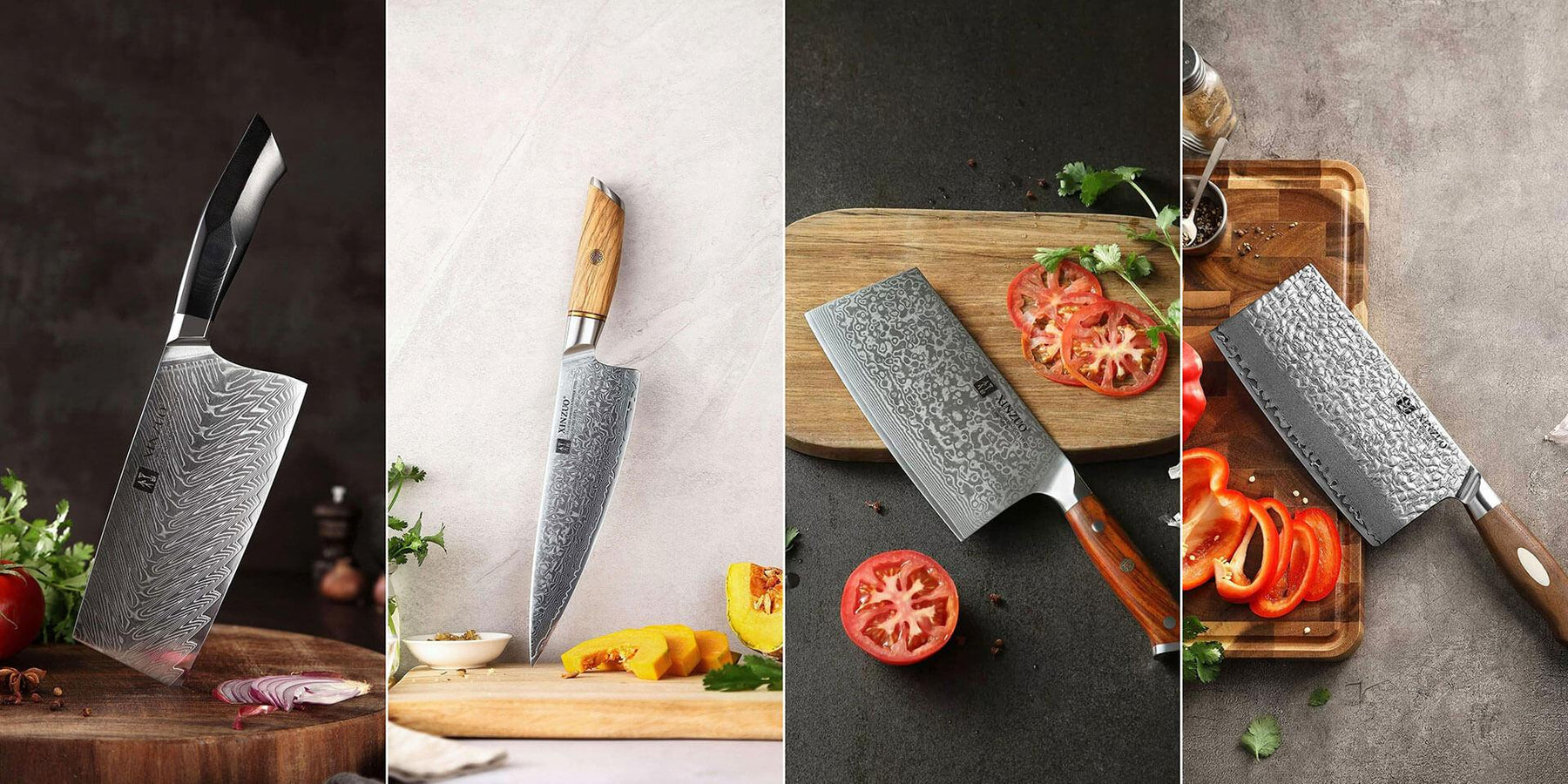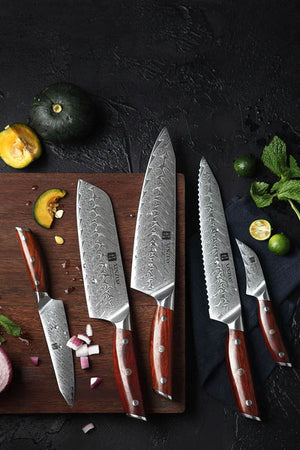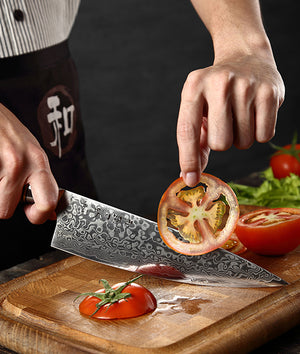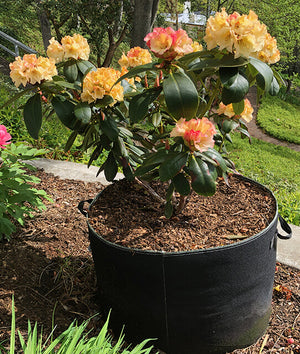
The Ultimate Guide to Chinese Knives
Cooking happily and successfully has a lot to do with the tools at your disposal. The more you have access to and the better quality you’re able to work with, the more likely it is that your experience will be pleasant. Of course, it’s bound to make things easier and more effective too.
Having the right equipment and tools comes down to several things. What you value and consider important often comes down to what type of food you enjoy cooking, your skill level, how often you cook, your budget, and your personal preferences, among other things. That being said, the best tools for one person may be completely different to the next.
One thing everyone needs, however, is good knives, although what makes a knife good for one person can be very different to the next – as per the factors we spoke about above.
So, bearing these things in mind, we want to tell you all about Chinese knives. That is, what they are, what it means for a knife to be Chinese, the properties of Chinese knives, the best types, our top recommended brands, and some skills and techniques you can use with Chinese kitchen knives. Because, believe it or not, although you may have a preconceived idea of what it means for a product to be Chinese (along with the connotations that go with the designation), you may find that there’s actually a lot you don’t know. And, even if you do know these things, you should stick around anyway, because we’re going to let you in on our favorite best Chinese knife brands.
Let’s dive right into the ultimate guide to Chinese knives.
What Does “Chinese” Mean When We Talk About Kitchen Knives?
Whether you know a lot about knives or absolutely nothing at all, one thing you probably are aware of is that “Chinese” doesn’t always bring along with it the most positive connotations. In fact, “Chinese” products are often associated with cheap materials and low quality. But why is that? And is it based in fact?
Well, it comes from the fact that lots of other types of products have historically been produced en masse in China. And, because they’ve been mass produced, the aim of manufacturing was to prioritize quantity over quality. While this may not sound great, there is, undoubtedly, a place for these types in products in most markets.
This idea and association has followed kitchenware, but there’s a key difference that many people don’t realize when it comes to knives – that is, the designation of a country isn’t always meant to specify place of origin. In fact, when it comes to knives, it’s actually a reference to style. And, it’s the style of the knife that originates in the country in question.
So, what we’re saying is a “Chinese Chef’s Knife”, for instance, is actually a knife made according to Chinese style, but it may be made anywhere in the world. That means that all the connotations regarding quality that are associated with Chinese knives aren’t actually relevant. Of course, that’s not to say that the quality is immediately good – it may very well still be poor. But, it may also be great. Thus, the important thing is that it comes down to the specific brand rather the designation of “Chinese”.
We’ll get into the properties of a Chinese-style knife shortly.
Why Is It Important?
Now you know what it means for a knife to be “Chinese” – it’s all about style. But why is it important to differentiate between origin of manufacturing and the style of a knife?
Well, if you’re into knives and you want to make sure you find what you’re looking for, then understanding the difference is essential.
- Quality: It doesn’t tell you the product is necessarily of a high or low quality. Rather, it removes the automatic assumption that the quality is inferior.
- Origin of Manufacturing: Once again, understanding that “Chinese” is about style and not where the product is made allows you to be open to the fact that the knife could be made anywhere in the world.
- Price: People often believe that “Chinese” products are automatically cheap, and if they’re not, you’re being ripped off. But understanding what “Chinese” really means will remove this assumption.
Those are the most important reasons why you should know what “Chinese” actually means. Now that you know why it’s important, it’s time to have a closer look at the properties of Chinese knives.
What Makes a Chinese Knife?
Describing exactly what makes a Chinese kitchen knife is a little bit more difficult than broaching the topic of their Japanese or Western counterparts. Japanese and Western knives, for instance, have some pretty clear properties that make them what they are and make them fairly easy to identify or, rather, distinguish from each other. But, Chinese kitchen knives are a little different.
Now, the first thing to be aware of, before we look at some general properties of Chinese knives is that there is actually one specific kind of knife that people often call a “Chinese knife”. What they’re talking about is a Chinese cleaver, sometimes even referred to as a “Chinese Chef’s knife”, even though it resembles a traditional cleaver rather than a Chef’s knife. We’ll tell you about the Chinese cleaver shortly, but for now, we want to explore Chinese style first, and what that actually means.
So, generally speaking, the main properties associated with Chinese knives is that they tend to be big, heavy, and shorter than other types of knives. This allows you to effectively use the knife in conjunction with classic Chinese knife techniques – namely, a rocking motion, moving from the tip towards the base of the blade, rather than exerting a massive amount of force. Thus, when it comes to style, Chinese kitchen knives tend to be known for being heavy, short, and large, and consequently, pretty strong.
Let’s do a quick comparison between Chinese knives and their Japanese and Western counterparts:
- Japanese kitchen knives are known for high quality and precision both in terms of design, as well as their performance. They’re not as heavy duty as Chinese kitchen knives or Western-style knives, but they’re great for precision tasks. The blades are generally sharper and thinner.
- Western kitchen knives tend to be more robust, strong, and durable, but they’re not nearly as well suited to precision as Japanese knives are. With blades that are thicker and stronger, they’re seen as more of a workhorse tool. Now, Chinese knives are probably closer to Western style than anything else, because they’re also strong, durable, and robust. But most people see Chinese knives as falling somewhere in between Western and Japanese.
Now you have a good idea of what a Chinese kitchen knife is, what it may look like, and what it should be used for – especially since there are specific techniques that you ought to use when using this kind of knife.
Let’s take a closer look at a Chinese cleaver, arguably the most common of all the Chinese kitchen knife types.
A Chinese Cleaver
A Chinese cleaver is known for its large, rectangular blade and wooden handle. So, from the outset, you may say that it’s pretty similar to a Western (otherwise referred to as German) cleaver. And, while it certainly shares some basic similarities, there are some major differences.
- Weight: Both knives are quite heavy, but a Chinese cleaver is heavier. And, most significantly, the weight distribution of the knife is quite different. While a Western cleaver boasts fairly even weight distribution throughout the blade and the handle, a Chinese cleaver carries most of its weight in its blade, making it front heavy.
- Tip: Western cleavers have more of a pointed tip, while Chinese cleavers tend to have blunt or even tapered, squared-off tips.
- Blade Shape: Both types of cleavers are broad and rectangular in shape, but Chinese cleavers are generally known to be broader. They’re also known for their very flat edge.
- Handle: Chinese cleavers are renowned for their wooden handles, while Western cleavers’ handles can be made from a broader variety of materials, including wood, metal, and so on.
- Blade Material: This can differ from one knife to the next, but Western cleavers’ blades are often made from strong materials like high-carbon steel, while Chinese cleavers are normally made from stainless steel. These days, you get both types that can be made from blends of strong alloys in order to strike the perfect balance between durability, resistance to corrosion, and strength.
What Can a Chinese Cleaver Be Used For?
Chinese cleavers are incredibly versatile and can be used for a plethora of tasks in the kitchen, despite them looking a little intimidating. Moreover, Chinese cleavers actually come in a few different shapes and sizes, so specific tasks are most suited to certain shapes.
With that in mind, here are the main uses of a Chinese cleaver:
- Chopping: Chopping is, arguably, the primary intended use of a Chinese cleaver. Wide blade and significant weight of the knife as a whole make it ideal for chopping, especially using a rocking motion. It’s also great at chopping up meat, and while it can be used for some smaller bones and cartilage, it’s not recommended that you use it on very large, hard bones.
- Slicing: All types of Chinese cleavers can be used for slicing, but the ones with the narrower blades are most suited to slicing precisely.
- Crushing: It’s great for crushing things like garlic because of the large, flat face of the knife.
- Transferring Ingredients: Since the blade is so big, a Chinese cleaver is ideal for transporting chopped up ingredients from your cutting board to the frying pan. The face is large and you’ll have plenty of space!
So, these are the most obvious uses of a Chinese cleaver knife – it really is an incredibly useful tool to have in your kitchen due to its epic functionality and impressive versatility.
But, now that you know more about Chinese knives (and Chinese cleavers specifically), how do you know which knife you should pick, and which brands you can trust?
Well, you’ve come to the right place, because we’ve done our research into Chinese knife brands, and we’ve found an two absolute winners.
Xinzuo: Our Top Recommended Chinese Kitchen Knives
So, what is the best Chinese knife brand? When I say that we searched high and low for the best Chinese kitchen knife brands, that we could trust and recommend to our customers, I really mean it. The aim was to find a brand that made knives that were both cost effective and offered exceptional value, because unfortunately, that can be a difficult balance to strike with any kind of knife.
But, low and behold, we struck gold when we came across Xinzuo & Hezhen. Offering a broad selection of knives made from high-quality materials and available at affordable prices, Xinzuo & Hezhen has managed to strike the balance we’ve been aiming for. And, we’re not the only ones who think so.
Chef Panko, a renowned professional chef and authority on cooking materials and equipment, has reached the same conclusion as us when it comes to Xinzuo’s & Hezhen knives. Here are the most important features of Xinzuo & Hezhen knives that Chef Panko (in agreement with us, of course) points out as the things that set them apart from competitors:
- Use of China’s VG10 steel, a super high-quality material along with other internationally renowned metals like Austria's Bohler M390, Japanese ZDP 189, Japanese Aus 10, Japanese SRS13, Swedish Sandvick 14C28N and German Din 1.4116 steel.
- Transparency regarding origin of manufacturing.
- Impeccable attention to detail.
- Use of precise heat retention methods.
And on top of all this, their customers love their products, and this is evident in the company’s significant rapid growth.
Chinese knife brands
Xinzuo’s 12-Step Knief-Making Process
As we mentioned before, one of the main reasons Xinzuo & Hezhen are our favorite Chinese kitchen knife brands is that every single step in the design and manufacturing process of their knives is meticulous and well thought out.
Here’s a quick summary of their 12-step knife-making process.
- Blade Shape Cutting: The shape of the blade is carved from a steel sheet by either laser cutting or press cutting – the former is ideal for smaller batches of more versatile blades, while the latter is great for larger batches of blades. Xinzuo & Hezhen can produce both.
- Thermal Hardening: This is done by means of vacuum heat treatment and deep freeze. It includes a few techniques, including annealing, tempering, case hardening, precipitation strengthening, and high temperature hardening. This is possibly one of the most important steps of the process, and lacking in most Chinese knife factories.
- Bolster Welding: By means of precise electrical welding, the bolster is welded to the blade.
- Grazing: The tip of the blade is polished using special materials to achieve a smooth and sleek curvature that is levelled and refined. Then, it’s polished (also known as grazing).
- Surface Blade Polishing: Then, the surface is polished (as opposed to the edge in the previous step). This helps achieve the desired bevel structure. It’s done by means of a water mill followed by fine polishing with a rubber wheel, producing a beautiful glossy face.
- Acid Etching and Abrasive Blasting: Fine glass particles are sprayed onto the face of the blade to enhance the natural aesthetic of the metal – this is especially relevant for Damascus steel. Then, they use acid etching to further enhance the pattern of the blade.
- Whetstone Sharpening: They continuously grind the blade against the whetstone while water is poured over it. This adds to the blade’s smoothness and sharpness.
- Assembling: The handle is secured to the bolster and blade with either glue screws. This is an essential part of ensuring that the knife is well-balanced, durable, and stable.
- Handle Polishing: The handle is polished to ensure it looks good – here, it’s all about aesthetics and attention to detail.
- Logo Application: The Xinzuo & Hezhen logos are applied by means of either laser printing, electric spark, or embossing, depending on the specific product and range.
- Product Inspection: Every knife produce is inspected according to strict protocol, checking their quality and consistency. It’s done in a special lab, assessing the most important qualities of the knives – cutting angle, sharpness, hardness, salt spray resistance (testing for corrosion), and more.
- Packaging: The knives are packaged carefully in such a way that the blades are protected and will reach their customers in good shape.
Every single step is done according to the strictest of standards, and that’s why Xinzuo & Hezhen and their products stand out from all the rest.
Chinese Knife Skills and Techniques
When it comes to knife techniques, all depends on the specific knife in question as well as the task that you’re using it for. But, at the end of the day, Chinese-style knives (especially Chinese cleavers) are heavier than other knives, and that’s what sets them apart when you need to use them.
The first thing to understand is that while the size and weight of the knife may be daunting, don’t be scared of it. Of course, be careful and aware of it, but don’t be scared. In fact, the weight of the blade is what will help you do really special things in the kitchen.
The general rule is that you should opt for a pinch grip between your thumb and your forefinger. Your forefinger can be reasonably relaxed, and your other three fingers are resting on the handle. Using this grip, you’ll be able to control the knife precisely with your pinch grip while maintaining control with the rest of your hand. Essentially, the idea is to let the knife do the work!
The recommended motion to use with Chinese cleaver, for instance, is slightly different to Western knives. You’re supposed to transfer the weight of the knife from the tip end towards the butt by following through in a smooth motion. But, don’t worry if you don’t get it right immediately – it takes some practice.
Final Thoughts on the Ultimate Guide to Chinese Knives
There you have it – the ultimate guide to Chinese kitchen knives. Now you know what they are, what “Chinese” actually means, and what a Chinese cleaver is, among other things. And, best of all, you even have a great recommendation for two best Chinese knife brands that we have tried and tested!
So, if you were unsure of Chines knives before, you certainly don’t need to be now. Check out our options for your best Chinese Cleaver a.k.a. best Chinese chef knife selections here with the Bamboo Guy today!



